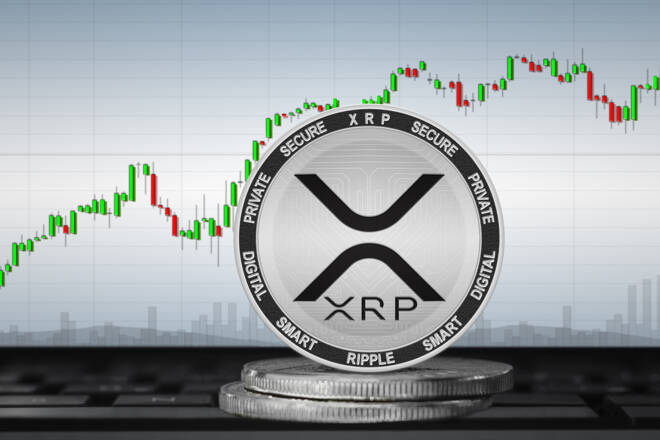Advertisement
Advertisement
XRP Faces Sub-$0.49 on Fed Fear and SEC v Ripple Silence
By:
It was a bullish end to a bearish week for XRP. A lack of updates from the SEC v Ripple case leaves investor sentiment toward the Fed to influence.
Key Insights:
- On Sunday, XRP joined the broader crypto market in positive territory, rising by 0.10% to end the day at $0.50589.
- The broader crypto market delivered support, while the lack of updates from the SEC v Ripple left XRP at sub-$0.51.
- However, the technical indicators remain bullish, signaling a return to $0.55.
On Sunday, XRP rose by 0.10%. Partially reversing a 1.50% loss from Saturday, XRP ended the week down by 2.47% to $0.50589. Despite the bullish session, XRP avoided sub-$0.49 for the fourth consecutive session.
A bullish start to the day saw XRP rise to an early high of $0.50882. Falling short of the First Major Resistance Level (R1) at $0.5112, XRP slid to a late afternoon low of $0.49931. XRP briefly fell through the First Major Support Level (S1) at $0.5013 before finding late support to wrap up the day at $0.50589.
SEC v Ripple Case Silence Leaves XRP Trailing the Broader Market
It was a quiet Sunday, with no updates from the ongoing SEC v Ripple case for investors to consider. The lack of updates during the Easter holidays left SEC v Ripple case-related chatter to influence.
On Sunday, Jeremy Hogan of Hogan & Hogan had this to say about the SEC v Ripple case,
“The #1 reason why XRP is not a security. First, under the legislative definition of a security, XRP can only POSSIBLY fit under the definition of an “investment contract.” It is not a stock or bond, etc… Even the SEC concedes this.”
In a series of tweets, Hogan pointed out that the SEC has failed to prove the existence of an implied or explicit contract of investment, arguing that only a purchase agreement is needed.
On this matter, Hogan said,
“As a simple purchase, without more, cannot be an investment contract, it is just an investment (like buying an ounce of gold) as there is no obligation for Ripple to do anything except transfer the asset.”
Hogan’s comments failed to spur an XRP breakout, with investors needing comments from the SEC, the defendants and council, and the Courts to move the dial.
Away from the SEC v Ripple case, Fed Fear resurfaced following the US Jobs Report on Friday, which left XRP under pressure over the weekend.
The Day Ahead
Investors should track the crypto news wires and Twitter chatter. SEC v Ripple case chatter will provide direction. However, ongoing SEC v Ripple case silence leaves regulatory activity in the spotlight. Binance and Coinbase (COIN) commentary will also move the dial.
There are no US economic indicators to influence the afternoon session, with increasing bets of a 25-basis point interest rate hike in May likely to test buyer appetite.
XRP Price Action
At the time of writing, XRP was down 0.77% to $0.50199. A mixed start to the day saw XRP rise to an early high of $0.50749 before falling to a low of $0.50049. XRP briefly fell through the First Major Support Level (S1) at $0.5005.
Technical Indicators
XRP needs to move through the $0.5047 pivot to target the First Major Resistance Level (R1) at $0.5100. A move through the Sunday high of $0.50882 would signal a bullish session. However, SEC v Ripple chatter would need to support a breakout.
In the case of an extended rally, XRP would likely test the Second Major Resistance Level (R2) at $0.5142 and resistance at $0.5150. The Third Major Resistance Level (R3) sits at $0.5237.
Failure to move through the pivot would leave the First Major Support Level (S1) at $0.5005 in play. However, barring an extended sell-off, XRP should avoid sub-$0.4900. The Second Major Support Level (S2) at $0.4952 should limit the downside. The Third Major Support Level (S3) sits at $0.4857.
The EMAs and the 4-hourly candlestick chart (below) sent bullish signals.
At the time of writing, XRP sat above the 100-day EMA, currently at $0.49144. The 50-day EMA moved away from the 100-day EMA, with the 100-day EMA widening from the 200-day EMA. The EMAs delivered bullish signals.
A move through the 50-day EMA ($0.50548) would support a breakout from R1 ($0.5100) to target R2 ($0.5142) and $0.52. However, failure to move through the 50-day EMA ($0.50548) would bring S1 ($0.5005) and sub-$0.50 into view. A move through the 50-day EMA would send a bullish signal.
About the Author
Bob Masonauthor
With over 28 years of experience in the financial industry, Bob has worked with various global rating agencies and multinational banks. Currently he is covering currencies, commodities, alternative asset classes and global equities, focusing mostly on European and Asian markets.
Advertisement
